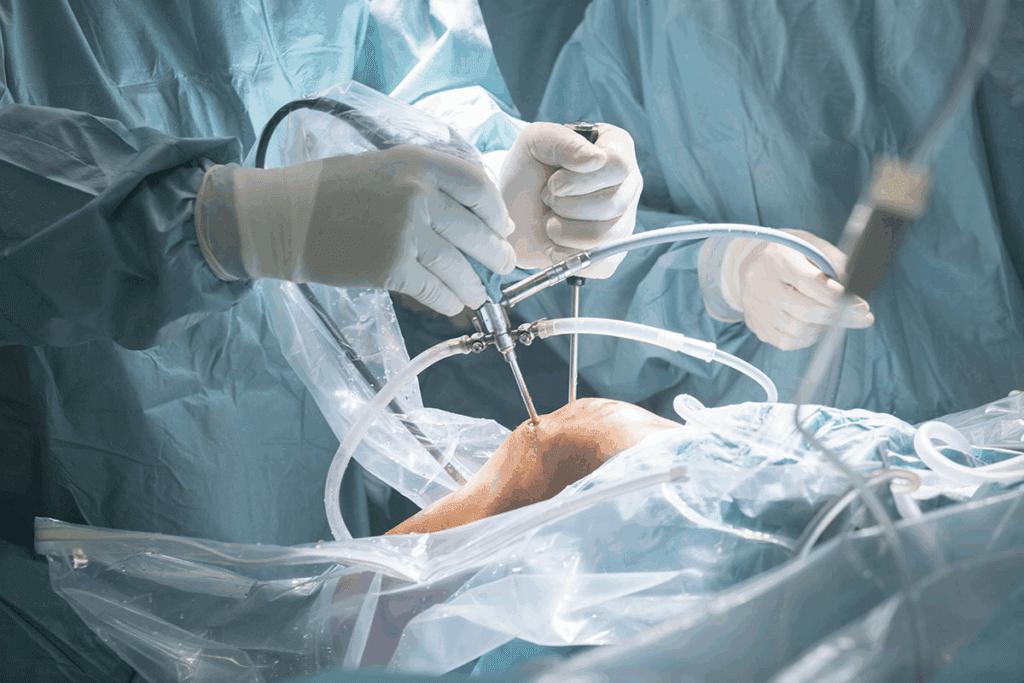Last Updated on November 4, 2025 by mcelik

Did you know some surgeries have a much higher risk of surgical complications? It’s important for both patients and doctors to know about these risks. This knowledge helps everyone make better choices.
Recent studies show that some high risk surgery has very high complication rates. These complex operations can lead to serious problems after surgery. This can affect how well a patient recovers and their overall outcome.
It’s vital to know about these risks. By understanding the possible surgery complication rate of different procedures, patients can make better health choices. This knowledge helps improve patient care and outcomes.

Surgical complications can greatly affect how well a patient recovers. They can come from many sources. These include the surgery’s complexity, the patient’s health, and how well they are cared for after surgery.
Surgical complications are problems that happen because of surgery or care after surgery. They can be sorted into different groups based on how serious they are, when they happen, and if they are related to the surgery.
Classification of Surgical Complications:
| Type of Complication | Description | Examples |
| Immediate | Occur during or shortly after surgery | Bleeding, anesthesia complications |
| Early | Develop within days or weeks after surgery | Infections, wound complications |
| Late | Arise months or years after surgery | Adhesions, long-term disability |
It’s important to track and report on surgical complications to better care for patients. Many metrics and registries help keep track of these issues, including how many patients get sick or die.
Key Metrics for Measuring Surgical Complications:
Understanding and tackling surgical complications is key to making surgery safer and better for patients. By classifying and measuring these issues, doctors and hospitals can find ways to improve and lower risks.

It’s important to know what affects surgical complications. These rates are a big worry. Many things can change how likely complications are.
Things about the patient can affect surgery risks. This includes their health, age, and any health problems like diabetes or heart disease.
Pre-existing conditions can really change the risk of problems during and after surgery. For example, diabetes can make wounds more likely to get infected and heal slower.
Each surgery has its own risks. The surgery’s complexity and type can greatly affect the chance of complications.
| Surgical Procedure | Common Complications | Risk Level |
| Cardiac Surgery | Bleeding, Infection, Stroke | High |
| Neurosurgery | Infection, Neurological Deficits, Seizures | High |
| Orthopedic Surgery | Infection, Blood Clots, Implant Failure | Moderate |
The team’s experience and the hospital’s quality also matter a lot. Hospitals that do a lot of certain surgeries usually do better. This is because the team is more familiar and efficient.
Surgeon expertise is key too. Surgeons who do a lot of a certain surgery tend to do better. They know the procedure well and can handle surprises better.
Knowing these factors helps doctors and hospitals make things better. They can work on making patients healthier before surgery, pick the right surgery, and make sure the team is experienced and works well together.
Cardiac surgery is known for its complexity and high-risk procedures like CABG and valve replacement. It’s often called open heart surgery. This surgery treats serious heart conditions that can be life-threatening or greatly reduce quality of life.
CABG is a common cardiac surgery. It aims to improve blood flow to the heart by bypassing blocked arteries. But, it carries risks like stroke, infection, and heart attack.
Valve replacement surgery replaces a damaged heart valve with a new one. This is vital for those with severe valve disease. Yet, it poses risks like bleeding, valve problems, and endocarditis.
Cardiac surgery can lead to serious complications. Some common ones are:
Knowing these risks is key for surgeons and patients to make smart choices about cardiac surgery.
It’s important for patients and doctors to know about neurosurgery risks. This field includes many procedures, like craniotomy and spinal surgery. Each one has its own set of possible problems.
A craniotomy is when part of the skull is removed to reach the brain. This can lead to infections, bleeding, and swelling. Postoperative care is critical to reduce these risks and help with recovery.
Research shows that the chance of complications after a craniotomy depends on several factors. These include the patient’s health, the surgery’s purpose, and the surgeon’s experience.
Spinal surgery also has its risks, like nerve damage, infections, and problems with implanted devices. Careful patient selection and precise surgical techniques are key to lowering these risks.
Spinal surgery is complex and requires a deep understanding of the patient’s anatomy. New surgical methods and technology have helped improve results. But, risks are always present.
Neurological problems after surgery can greatly affect a patient’s life. These issues can be minor or severe, affecting movement and sensation. The risk depends on the surgery type and the area treated.
Long-term results after neurosurgery depend on several factors. These include the patient’s health before surgery, how well the surgery goes, and post-surgery care. Rehabilitation is vital in helping patients adjust to any lasting effects.
Thoracic surgery includes many complex procedures like lung resection and esophageal surgery. These surgeries are done to treat lung and esophageal cancers and other diseases. They need careful planning before and after surgery to avoid complications.
Lung resection is a big surgery that removes part or all of a lung. It can lead to respiratory failure, pneumonia, and prolonged air leaks. Some complications are mild and short-lived, while others are serious.
The risk of complications depends on the patient’s health, lung disease, and surgery extent. Those with lung diseases like COPD face higher risks.
Esophageal surgery, like esophagectomy, is complex and risky. It can cause leakage, stricture, and swallowing problems. These issues can greatly affect a patient’s life quality and may need extra treatments.
Esophageal surgery faces many challenges, from the surgery itself to postoperative care. Nutritional support is key in recovery, as many struggle to eat after surgery.
Respiratory problems after thoracic surgery are a big worry, mainly for lung procedures. Issues like atelectasis, pneumonia, and ARDS can happen. Good postoperative care includes respiratory therapy and early movement.
Handling respiratory issues after surgery needs a team effort. Quick action and treatment are vital to lessen complications and better outcomes.
Surgeries in the abdominal and digestive tract can be tricky. They often come with complications.
These surgeries include pancreatic, liver, and colorectal procedures. Each one has its own set of risks.
Pancreatic surgery is very complex. It has a high risk of problems. Pancreatitis, infection, and leakage from the pancreatic anastomosis are common issues.
A study found that up to 40% of patients face complications. Some need to have surgery again.
Liver surgeries are risky. Liver failure, bleeding, and infection are possible complications.
Liver transplants also face risks like graft rejection. This is due to the need for immunosuppression.
| Complication | Liver Resection | Liver Transplantation |
| Liver Failure | 15% | 10% |
| Bleeding | 10% | 8% |
| Infection | 12% | 15% |
Colorectal surgery, like for colon and rectal cancer, has risks. Infection, anastomotic leakage, and bowel obstruction are some of them.
The risk depends on the procedure, patient health, and surgical method.
It’s important to know these risks. This helps with informed consent and reduces complications.
Organ transplantation is a lifesaving surgery but comes with risks. It’s not just about moving an organ. It’s about managing the challenges that come after.
Liver transplants are complex and risky. They can face surgical issues, rejection, and disease return. Patients also risk infections due to immunosuppression.
Common complications include:
Kidney transplants are a treatment for kidney failure but have risks. These include surgical issues, rejection, and disease return in the new kidney.
Immunosuppression, needed to prevent rejection, raises infection and cancer risks.
Dealing with rejection and immunosuppression is tricky. Immunosuppressants prevent rejection but increase infection and other risks.
| Complication | Liver Transplant | Kidney Transplant |
| Rejection | Common, can be acute or chronic | Common, can be acute or chronic |
| Infection | High risk due to immunosuppression | High risk due to immunosuppression |
| Surgical Mortality | Low but significant risk | Low but significant risk |
Knowing these risks is key to better patient care and outcomes in organ transplants.
In trauma surgery, the line between success and trouble is very thin. These surgeries are urgent and the patients are in critical condition.
Trauma surgery includes many procedures. These range from damage control to managing multiple traumas. Each has its own challenges and risks.
Damage control surgery is used to save patients with severe injuries. It’s lifesaving but comes with big risks. These include infection, organ failure, and the need for more surgeries.
This surgery is complex. It involves an initial surgery to stop bleeding and prevent contamination. Then, more surgeries are needed for final repairs.
Dealing with patients who have many injuries is tough. It takes teamwork among different surgical teams to handle their complex conditions well.
Big challenges include controlling bleeding, treating injuries to many organs, and avoiding sepsis and organ failure.
In trauma surgery, quick decisions are key. Surgeons must make fast choices that can greatly affect patient results.
Being able to order injuries, manage resources well, and make quick decisions is vital. This is true in the high-pressure world of trauma surgery.
Obesity rates are rising fast, making bariatric surgery a big deal. It offers benefits but also risks. Procedures like gastric bypass and sleeve gastrectomy are common. They help with weight loss and health issues but come with complications.
Gastric bypass surgery makes a small stomach pouch and changes the intestine route. It’s effective but can cause problems like:
Gastric bypass patients need lifelong check-ups to watch for these issues.
Sleeve gastrectomy removes a big part of the stomach, leaving a narrow “sleeve.” It can lead to:
Bariatric surgery patients face long-term nutritional issues. This is because of changes in their body and less nutrient absorption. Common problems include:
| Nutritional Deficiency | Symptoms | Prevention/Treatment |
| Vitamin B12 | Fatigue, weakness, neurological changes | Supplementation, regular monitoring |
| Iron | Anemia, fatigue, shortness of breath | Iron supplements, dietary adjustments |
| Calcium | Osteoporosis, bone pain | Calcium and Vitamin D supplements |
It’s key to see a healthcare provider regularly to manage these risks and keep nutritional levels right after surgery.
Orthopedic surgery is generally safe but can lead to complications. These procedures include joint replacement and spinal fusion. Each has its own risks and challenges.
Joint replacement, like hip or knee surgery, is common and often successful. Yet, it comes with risks. These can include infection, blood clots, and implant failure. The risk varies based on the joint and the patient’s health.
Infection is a big risk, with deep infections being hard to treat. Periprosthetic joint infection is a serious issue. It may need more surgery and long-term antibiotics.
| Complication | Frequency | Management |
| Infection | 1-3% | Antibiotics, possible additional surgery |
| Blood Clots | 2-5% | Anticoagulant medication |
| Implant Failure | 1-2% | Revision surgery |
Spinal fusion treats various spinal issues. Complications can include infection, nerve damage, and hardware failure. The risk depends on the procedure’s complexity and the patient’s health.
Nerve damage is a risk, causing numbness, weakness, or pain. In severe cases, this damage can be permanent.
Recovery from orthopedic surgery needs careful management. This ensures the best outcomes. Rehabilitation is key to regaining strength and function.
Recovery challenges include managing pain, preventing infection, and keeping mobility. A good rehabilitation plan is vital to overcome these hurdles.
Knowing the possible complications of orthopedic surgery is important. Surgeons and patients can take steps to reduce these risks. This leads to better results.
Surgical complications are a big worry in many medical fields. They can affect how well a patient recovers, how long they stay in the hospital, and the cost of care.
Postoperative infections are a big worry in surgery. These can happen in the wound, urinary tract, or lungs. Postoperative pneumonia and surgical site infections are common. Factors like the patient’s health, the surgery type, and care before and after surgery play a role.
Bleeding and hematoma are risks during or after surgery. Hemorrhage is very serious and needs quick action. Hematomas, or blood clots outside blood vessels, can also cause problems if not treated right.
Anesthesia can cause problems, from small issues to serious ones. Respiratory depression and anaphylaxis are serious risks.
Venous thromboembolism (VTE), like deep vein thrombosis (DVT) and pulmonary embolism (PE), is a big risk for surgery patients. Doctors use anticoagulation therapy and compression devices to prevent it.
“The prevention of VTE is a critical aspect of surgical care, requiring a multifaceted approach that includes risk assessment, prophylaxis, and surveillance.”
Source: American Society of Hematology
Knowing about these common surgical complications is key to better patient care. By understanding the risks and using proven methods, doctors can lessen these problems.
Surgical complications can greatly affect patient outcomes. It’s vital to look at the data on these events. This helps healthcare professionals understand the risks of different surgeries.
Mortality rates after surgery are key to understanding risks. Different surgeries have different risks, based on patient health, surgery complexity, and care after surgery.
Morbidity statistics show the complications that can happen with surgery. They help us understand how often and what kinds of complications happen with different surgeries.
Looking at trends in surgical outcomes helps us find ways to improve. It shows how new techniques and better care after surgery affect results.
By studying the statistics on surgery complications, healthcare providers can find ways to improve care. This can help reduce complications for patients.
Choosing to have a high-risk surgery is a big decision. It involves knowing the risks and benefits well. Patients need to think about their health, how serious their condition is, and what the surgery might do.
Understanding the risk-benefit analysis is key. This means looking at the surgery’s good points, like better health or symptom relief, against its bad points, like complications or death.
Key factors to consider in a risk-benefit analysis include:
To make a good choice, ask your surgeon important questions. These can help you understand the surgery’s risks and benefits. Some questions to ask are:
It’s important to know how experienced your surgeon is with the procedure and what they expect.
Getting a second opinion is a smart move for high-risk surgeries. It lets you check the first diagnosis and treatment plan. It also lets you look at other options.
It’s a good idea to talk to a specialist in another hospital or medical center. This can give you a wider view of your treatment choices.
Knowing the risks of different surgeries is key to making smart choices. The chance of complications varies a lot, depending on the surgery type. Some surgeries are riskier than others.
High-risk surgeries, like heart and brain operations, need careful thought. Patients should understand these risks. This way, they can talk to their doctors about how to lower these risks.
Being aware of surgery risks helps patients talk better with their surgeons. It also helps them make better choices about their care. This knowledge is vital for getting the best results from surgery.
Cardiac surgery, like CABG and valve replacement, can cause problems. These include stroke, bleeding, infection, and heart rhythm issues. The risk depends on the patient’s health and the surgery’s complexity.
A patient’s age, health, and other conditions can greatly affect surgery risks. People with diabetes or heart disease face higher risks during and after surgery.
Neurosurgery and brain surgery have risks like neurological problems, infection, bleeding, and stroke. The surgery’s complexity and the patient’s health play a big role in these risks.
Thoracic surgery, like lung removal and esophageal surgery, can cause breathing issues, infection, and bleeding. The patient’s health and the surgery’s complexity affect these risks.
Experience matters a lot in surgery. Hospitals and surgeons who do many procedures have fewer complications. This is because they are more skilled and have better techniques.
Organ transplants, like liver and kidney transplants, have risks like rejection, infection, and problems from immunosuppression. The patient’s health and the surgery’s complexity influence these risks.
Patients can make smart choices by understanding the risks and benefits. They should ask their surgeon questions and get second opinions. This helps them know what to expect from their surgery.
Orthopedic surgery, like joint replacement and spinal fusion, can lead to issues like infection, bleeding, and nerve damage. The patient’s health and the surgery’s complexity affect these risks.
Postoperative care is key to avoiding complications. Proper wound care, pain management, and watching for complications can reduce risks. This helps ensure a safe recovery.
Patients can lower their risk by following their surgeon’s advice, staying healthy, and managing health conditions. This helps avoid complications and makes recovery smoother.
Subscribe to our e-newsletter to stay informed about the latest innovations in the world of health and exclusive offers!